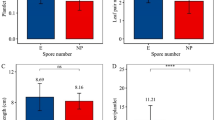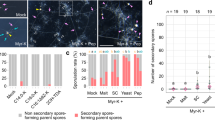Abstract
Vesicular arbuscular mycorrhizal fungi can reduce plant disease symptoms and populations of pathogens through mechanisms that are not well understood. Glomus intraradices was grown on Daucus carota transformed roots in a two-compartment in vitro system. One compartment contained mycorrhizal roots on a complete growth medium, while the other contained a medium lacking sugar on which only mycelial growth was allowed. The direct interaction between G. intraradices and Fusarium oxysporum f. sp. chrysanthemi was studied in the compartment lacking sugar during a 5-day period. G. intraradices hyphal density and spore number were estimated along with F. o. chrysanthemi conidial germination, mycelial growth and sporulation. Five hours after inoculation, germination of F. o. chrysanthemi conidia doubled in the presence of G. intraradices. Radial growth of F. o. chrysanthemi colonies was always slightly but significantly enhanced in the presence of G. intraradices. No correlation was obtained between G. intraradices hyphae or spore densities and F. o. chrysanthemi hyphal growth. Overall sporulation of the 5-day-old F. o. chrysanthemi colonies was not influenced by the presence of G. intraradices. However, significant negative correlations were found between F. o. chrysanthemi conidia production and G. intraradices hyphae or spore concentrations. G. intraradices increased F. o. chrysanthemi conidial germination and slightly stimulated its hyphal growth in dual culture without any root influences. No antibiosis was observed between the fungi. The significance of the results and their potential implication for rhizosphere biology are discussed.
Similar content being viewed by others
References
Ames RN, Reid CPP, Ingham ER (1984) Rhizosphere bacterial population responses to root colonization by a vesicular-arbuscular mycorrhizal fungus. New Phytol 96:555–563
Azcón R (1987) Germination and hyphal growth of Glomus mosseae in vitro: effects of rhizophere bacteria and cell-free culture media. Soil Biol Biochem 19:417–419
Azcón R (1989) Selective interaction between free-living rhizophere bacteria and vesicular-arbuscular mycorrhizal fungi. Soil Biol Biochem 21:639–644
Azcón-Aguilar C, Barea JM (1992) Interactions between mycorrhizal fungi and other rhizosphere microorganisms. In: Allen MF (ed) Mycorrhizal functioning. Chapman & Hall, London, pp 163–198
Azcón-Aguilar C, Diaz-Rodriguez R, Barea JM (1986) Effects of soil microorganisms on spore germination and growth of the vesicular-arbuscular mycorrhizal fungus Glomus mosseae. Trans Br Mycol Soc 86:337–340
Bagyaraj DJ, Menge JA (1978) Interaction between a VA myorrhiza and Azotobacter and their effects on rhizosphere microflora. New Phytol 80:567–573
Baltruschat H, Schönbeck F (1975) Untersuchungen über den Einfluss der endotrophen Mykorrhiza auf den Befall von Tabak mit Thielaviopsis basicola. Phytopathol Z 84:172–188
Bécard G, Fortin JA (1988) Early events of vesicular-arbuscular mycorrhiza formation on Ri T-DNA transformed roots. New Phytol 108:211–218
Benhamou N, Fortin JA, Hamel C, St-Arnaud M, Shatilla A (1994) Resistance responses of mycorrhizal Ri T-DNA-transformed carrot roots to infection by Fusarium oxysporum f. sp. chrysanthemi. Phytopathology 84:958–968
Calvet C, Barea JM, Pera J (1992) In vitro interactions between the vesicular-arbuscular mycorrhizal fungus Glomus mosseae and some saprophytic fungi isolated from organic substrates. Soil Biol Biochem 24:775–780
Caron M (1989) Potential use of mycorrhizae in control of soilborne diseases. Can J Plant Pathol 11:177–179
Caron M, Fortin JA, Richard C (1985) Influence of substrate on the interaction of Glomus intraradices and Fusarium oxysporum f. sp. radicis-lycopersici on tomatoes. Plant Soil 87:233–239
Caron M, Fortin JA, Richard C (1986) Effect of phosphorus concentration and Glomus intraradices on Fusarium root rot of tomatoes. Phytopathology 76:942–946
Catska V (1994) Interrelationships between vesicular-arbuscular mycorrhiza and rhizosphere microflora in apple replant disease. Biol Plant 36:99–104
Christensen H, Jakobsen I (1993) Reduction of bacterial growth by a vesicular-arbuscular mycorrhizal fungus in the rhizosphere of cucumber (Cucumis sativus L.). Biol Fertil Soils 15:253–258
Clough KS, Sutton JC (1978) Direct observations of fungal aggregates in sand dune soil. Can J Microbiol 24:333–335
Codignola A, Verotta L, Spanu P, Maffei M, Scannerini S, Bonfante-Fasolo P (1989) Cell wall bound-phenols in roots of vesicular-arbuscular mycorrhizal plants. New Phytol 112:221–228
Curl EA, Truelove B (1986) The rhizosphere. Springer-Verlag, Berlin Heidelberg New York
Deakin MAB (1990) Catastrophe modelling in the biological sciences. Acta Biotheor 38:3–22
Dehne H-W (1982) Interaction between vesicular-arbuscular myorrhizal fungi and plant pathogens. Phytopathology 72:1115–1119
Dehne H-W, Schönbeck F (1979) Untersuchungen zum Einfluß der endotrophen Mykorrhiza auf Pflanzenkrankheiten. II. Phenolstoffwechsel und Lignifizierung. Phytopathol Z 95:210–216
Dehne H-W, Schönbeck F, Baltruschat H (1978) Untersuchungen zum Einfluß der endotrophen Mykorrhiza auf Pflanzenkrankheiten. III. Chitinase-Aktivität und Ornithinzyklus. Z Pflanzenkr Pflanzenschutz 85:666–678
Draper NR, Smith H (1981) Applied regression analysis. Wiley, New York
Dumas E, Gianinazzi-Pearson V, Gianinazzi S (1989) Production of new soluble proteins during VA endomycorrhiza formation. Agric Ecosyst Environ 29:111–114
Dumas E, Tahiri-Alaoui A, Gianinazzi S, Gianinazzi-Pearson V (1990) Observations on modifications in gene expression with VA endomycorrhiza development in tobacco: qualitative and quantitative changes in protein profiles. In: Nardon P, Gianinazzi-Pearson V, Grenier AM. Margulis L, Smith DC (eds) Endocytobiology. INRA Press, Paris, pp 153–157
Garcia-Garrido JM, Ocampo JA (1988) Interaction between Glomus mosseae and Erwinia carotovora and its effects on the growth of tomato plants. New Phytol 110:551–555
Garcia-Garrido JM, Ocampo JA (1989) Effect of VA mycorrhizal infection of tomato on damage caused by Pseudomonas syringae. Soil Biol Biochem 21:165–167
Gianinazzi-Pearson V, Tahiri-Alaoui A, Antoniw JF, Gianinazzi S, Dumas E (1992) Weak expression of the pathogenesis related PR-b1 gene and localization of related protein during symbiotic endomycorrhizal interactions in tobacco roots. Enocytobiosis Cell Res 8:177–185
Graham JH (1986) Citrus mycorrhizae: potential benefits and interactions with pathogens. Hortscience 21:1302–1306
Grandmaison J, Olah GM, Van Calsteren M-R, Furlan V (1993) Characterisation and localization of plant phenolics likely involved in the pathogen resistance expressed by endomycorrhizal roots. Mycorrhiza 3:155–164
Griffin G (1981) Physiology of conidium and chlamydospore germination in Fusarium. In: Nelson P, Toussoum T, Cook R (eds) Fusarium: diseases, biology, and taxonomy. Pennsylvania State University Press, University Park, Pa, pp 331–339
Hale MG, Moore LD, Griffin GJ (1978) Root exudates and exuation. In: Dommergues YR, Krupa SV (eds) Interactions between non-pathogenic soil microorganisms and plants. Elsevier, New York, pp 103–203
Harrison MJ, Dixon RA (1993) Isoflavonoid accumulation and expression of defense gene transcripts during the establishment of vesicular-arbuscular mycorrhizal associations in roots of Medicago truncatula. Mol Plant Microbe Interaction 6:643–654
Krishna KR, Bagyaraj DJ (1983) Interaction between Glomus fasciculatum and Sclerotium rolfsii in peanut. Can J Bot 61:2349–2351
Krishna KR, Balakrishna AN, Bagyaraj DJ (1982) Interaction between a vesicular-arbuscular mycorrhizal fungus and Streptomyces cinnamomeous and their effects in finger millet. New Phytol 92:401–405
Lehmann E (1975) Nonparametrics — statistical methods based on ranks. In: Lehmann E (ed) Holden-Day series in probability and statistics. Holden-Day, Oakland, Calif
Lieberei R, Feldmann F (1989) Physiological changes in roots colonized by vesicular arbuscular mycorrhizal fungi —reactions in mutualistic and parasitic interactions. Agric Ecosyst Environ 29:251–255
Linderman RG (1988) Mycorrhizal interactions with the rhizosphere microflora: the mycorrhizosphere effect. Phytopatholoy 78:366–371
Linderman RG (1992) Vesicular-arbuscular mycorrhizae and soil microbial interactions. In: Bethlenfalvay GJ, Linderman RG (eds) Mycorrhizae in sustainable agriculture. American Society of Agronomy Special Publication No 54, Madison, Wis, pp 45–70
Linderman RG (1994) Role of VAM fungi in biocontrol. In: Pfleger FL, Linderman RG (eds) Mycorrhizae and plant health. APS Press, St Paul, Minn, pp 1–25
Linderman RG, Paulitz TC (1990) Mycorrhizal-rhizobacterial ineractions. In: Hornby D, Cook RJ, Henis Y, Ko WH, Rovira AD, Schippers B, Scott PR (eds) Biological control of soilborne plant pathogens. CAB International, Wallingford, UK, pp 261–283
Lockwood JL (1977) Fungistasis in soils. Biol Rev 52:1–43
Malajczuk N (1979) The microflora of unsuberized roots of Eucalyptus calophylla R. Br. and Eucalyptus marginata Donn ex Sm. seedlings grown in soils suppressive and conducive to Phytophthora cinnamomi Rands. II. Mycorrhizal roots and associated microflora. Aust J Bot 27:255–272
Marx D (1972) Ectomycorrhizae as biological deterrents to pathogenic root infections. Annu Rev Phytopathol 10:429–454
Mayo K, Davis R, Motta J (1986) Stimulation of germination of spores of Glomus versiforme by spore-associated bacteria. Mycologia 78:426–431
McAllister CB, Garcia Romera I, Godeas A, Ocampo JA (1994) In vitro interactions between Trichoderma koningii, Fusarium solani and Glomus mosseae. Soil Biol Biochem 26:1369–1374
Meyer JR, Linderman RG (1986a) Response of subterranean clover to dual inoculation with vesicular-arbuscular mycorrhizal fungi and a plant growth-promoting bacterium, Pseudomonas putida. Soil Biol Biochem 18:185–190
Meyer JR, Linderman RG (1986b) Selective influence on populations of rhizosphere or rhizoplane bacteria and actinomycetes by mycorrhizas formed by Glomus fasciculatum. Soil Biol Biochem 18:191–196
Morandi D, Bailey JA, Gianinazzi-Pearson V (1983) Isoflavonoid accumulation in soybean roots infected with vesicular-arbuscular mycorrhizal fungi. Physiol Plant Pathol 24:357–364
Mugnier J, Mosse B (1987) Spore germination and viability of a vesicular-arbuscular fungus Glomus mosseae. Trans Br Mycol Soc 88:411–413
Nirenberg HI (1981) A simplified method for identifying Fusarium spp. occurring on wheat. Can J Bot 59:1599–1609
Oliveira E, Sieverding E, Toro S (1987) Interaction between three species of VAM fungi and one isolate of Pseudomonas putida on cassava. In: Sylvia DM, Hung LL, Graham JH (eds) Proceedings of the 7th North American Conference on Mycorrhizae. Institute of Food and Agricultural Sciences, University of Florida, Gainesville, Fla, pp 216
Orozco MO, Fernandez E, Prikryl Z, Vancura V, Herrera RA (1984) Observacionez del micelio extramatrico de las micorrizas vesiculo-arbusculares al microscopio electronico de barrio. Acta Bot Cubana 20:88–92
Papavizas GC (1985) Trichoderma and Gliocladium: biology, ecology, and potential for biocontrol. Annu Rev Phytopathol 23:23–54
Papavizas GC, Lumsden RD (1980) Biological control of soil borne fungal propagules. Annu Rev Phytopathol 18:389–413
Paula M, Siquira J, Döbereiner J (1993) Ocorrência de fungos micorrízicos vesiculoarbusculares e de bactérias diazotróficas na cultura da batata-doce. Rev Bras Ci Solo Campinas 17:349–356
Paulitz TC, Linderman RG (1989) Interactions between fluorescent pseudomonads and VA mycorrhizal fungi. New Phytol 113:37–45
Perrin R (1990) Interactions between mycorrhizae and diseases caused by soil-borne fungi. Soil Use Manage 6:189–195
SAS Institute (1992) The SAS system for Windows 3.10, release 6.08. SAS Institute Inc, Cary, NC
Schönbeck F (1979) Endomycorrhiza in relation to plant diseases. In: Schippers B, Gams W (eds) Soil-borne plant pathogens. Academic Press, London New York San Francisco, pp 271–280
Secilia J, Bagyaraj DJ (1987) Bacteria and actinomycetes assoiated with pot cultures of vesicular-arbuscular mycorrhizas. Can J Microbiol 33:1069–1073
Secilia J, Bagyaraj DJ (1988) Fungi associated with pot cultures of vesicular arbuscular mycorrhizas. Trans Br Mycol Soc 90:117–119
Spanu P, Bonfante-Fasolo P (1988) Cell-wall bound peroxidase activity in roots of mycorrhizal Allium porrum. New Phytol 109:119–124
St-Arnaud M, Hamel C, Caron M, Fortin JA (1994) Inhibition of Pythium ultimum in roots and growth substrate of mycorrhizal Tagetes patula colonized with Glomus intraradices. Can J Plant Pathol 16:187–194
Strzelczyk E, Pokojska-Burdziej A (1984) Production of auxins and gibberellin-like substances by mycorrhizal fungi, bacteria and actinomycetes isolated from soil and the mycorrhizosphere of pine (Pinus sylvestris L.) in dixenic cultures with bacteria in media of different composition. Plant Soil 81:185–194
Sylvia DM, Sinclair WA (1981) A proposed role for low level antibiotic activity of an ectomycorrhizal fungus. Phytopathology 71:260
Tisdall J, Oades J (1979) Stabilization of soil aggregates by the root systems of ryegrass. Aust J Soil Res 17:429–441
Tsantrizos YS, Kope HH, Fortin JA, Ogilvie KK (1991) Antifungal antibiotics from Pisolithus tinctorius. Phytochemistry 30:1113–1118
Vancura V, Orozco MO, Grauova O, Prikry Z (1989) Properties of bacteria in the hyphosphere of a vesicular-arbuscular myorrhizal fungus. Agric Ecosyst Environ 29:421–427
Wyss P, Boller T, Wiemken A (1989) Glyceollin production in soybean during the process of infection by Glomus mosseae and Rhizoctonia solani. Agric Ecosyst Environ 29:451–456
Author information
Authors and Affiliations
Rights and permissions
About this article
Cite this article
St-Arnaud, M., Hamel, C., Vimard, B. et al. Altered growth of Fusarium oxysporum f. sp. chrysanthemi in an in vitro dual culture system with the vesicular arbuscular mycorrhizal fungus Glomus intraradices growing on Daucus carota transformed roots. Mycorrhiza 5, 431–438 (1995). https://doi.org/10.1007/BF00213444
Issue Date:
DOI: https://doi.org/10.1007/BF00213444




